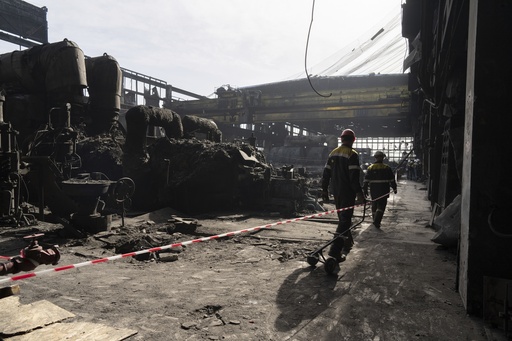BAKU, Azerbaijan — Maxim Timchenko, the CEO of DTEK, Ukraine’s largest private energy firm, recently unveiled data illustrating the contrast between the restoration of electricity in Ukraine and the destruction caused by Russian missile strikes. He displayed a paper filled with bar charts that highlighted the ongoing challenges his company faces: a cycle of increasing and decreasing electricity output as facilities are rebuilt after being damaged by bombings. This pattern of resilience is particularly evident in light of the Russian military’s targeted assaults on energy infrastructure as winter approaches.
During a discussion on the sidelines of COP29, the U.N. climate talks in Azerbaijan, Timchenko emphasized the urgency of their situation. “What other choice do we have?” he remarked, stressing the importance of being proactive rather than merely hoping for the best amid the ongoing threat. “We have to do our job and restore power for our people.”
The ongoing Russia-Ukraine conflict, which has ravaged significant portions of Ukraine over nearly three years, has unexpectedly accelerated the shift toward renewable energy sources. At Ukraine’s exhibit at COP29, a charred solar panel remains on display as a testament to the brutal impact of the war.
Recently, Russian forces have been making gradual territorial gains in Ukraine, raising concerns about the U.S. commitment to provide support in the wake of a potential change in leadership. Speculation looms over how President-elect Donald Trump might alter American involvement, as he claimed he could swiftly resolve the conflict, yet failed to outline a clear plan.
Amid these uncertainties, the decentralized nature of renewable energy, particularly wind and solar power, has enabled Ukraine to restore its electricity supply more efficiently than could be achieved through conventional sources like coal. Traditional energy systems centralize generation, meaning that if one facility is attacked, a large segment of the electricity grid could fail. In contrast, distributed installations mean that damage to one area doesn’t necessarily disrupt service elsewhere—rooftop solar systems can sustain operations even if ground-based facilities are targeted.
Timchenko recounted an example from last spring when two solar farms operated by DTEK were hit, damaging solar panels and transformers. Remarkably, after replacing the equipment, these farms, which together can produce 400 megawatts, were operational again within just seven days. In stark contrast, a thermal power station hit by a similar attack required three to four months for repairs.
“The difference lies in the resilience of decentralized generation,” Timchenko noted, highlighting how distributed systems can withstand attacks more effectively.
Geoffrey Pyatt, who serves as the assistant secretary in the U.S. State Department’s Bureau of Energy Resources, commented on the evolving strategy behind Russian assaults on Ukraine’s energy infrastructure. Over the past two years, the emphasis has shifted from damaging transformers to targeting generation capabilities. He explained that Ukraine’s innovative response has forced Russian forces to alter their tactics to remain effective.
Moreover, Pyatt revealed that nearly half of Ukraine’s power generation capacity has been compromised due to these attacks, with nuclear and hydropower plants, as well as emerging renewable projects, still operational.
Collaborative initiatives between governments and the private sector are essential for financing renewable and infrastructure projects, as the risk of destruction from missile attacks persists. Notably, in June, major turbine manufacturer GE Vernova and Honeywell announced their cooperation with DTEK on significant wind and battery storage deployments in Ukraine.
Roger Martella, GE Vernova’s chief sustainability officer, pointed out the importance of public-private partnerships in mitigating risks and fostering investment. Speaking at the COP29 panel focused on Ukraine’s renewable energy landscape, Martella commended Ukraine’s unique resilience in maintaining its electricity grid amid ongoing conflict.
Pyatt, who previously served as the U.S. ambassador to Ukraine, observed strong support for Ukrainian energy initiatives among G7 nations, underscoring the belief that energy sector assistance would persist regardless of the incoming administration. “With significant American companies like GE and Honeywell getting involved in energy reconstruction, there are certainly going to be vast expenditures for energy recovery,” he remarked.



